|
|
|
NU Football
Unofficial Origin
Page Created
4/14/03;
Updated
8/24/25
|
|
|
|
 |
|
|
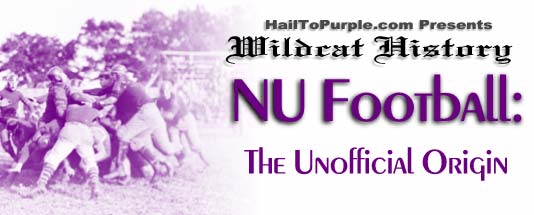

by Larry LaTourette
This
page is called "The Unofficial Origin of NU Football," and it first
posted to HTP back in 2003. However, as of August 2025 the origin is no
longer unofficial. Northwestern has now formally recognized NU's first
game, played in February 1876 and features it in the program's 2025 Football Media Guide.
I wrote much of the description below as I was researching my book about this game, Gus Hornsby's Gamble.
When Chicago football fans think of the great names from the city's
gridiron past, Augustus H. Hornsby doesn't exactly flash to the front
of the list. In fact, except for a few small mentions in a couple
of football history books written by Alexander Weyand in the 1950s,
A.H. Hornsby is now totally forgotten.
A shame, that, since A.H. Hornsby introduced organized football to
Chicago in 1875, and is directly responsible for bringing organized
football to Northwestern University.
I write "organized football" to distinguish what Hornsby accomplished
from what passed for American football in Chicago before 1875.
Yes, football of a sort was being played in the Windy City even
then. As early as the mid 1860s, teams throughout the city were
playing the crude soccer-rugby combination that would eventually evolve
into American football. However, the teams were not specifically
football teams, but general athletic clubs, playing football as part of
a set of games during picnics or field day events.
Typical of such events is a notice that appeared in the Chicago Tribune
on July 18, 1869. In it, the Trib announced that the Irish Rides
(Sheridan Guards) would hold a picnic at Haas Park1 in
August. During the picnic there was to be "a grand game of
football between the twelve of the Rides and the same number of
Zonaves, the victors to retain the ball."
Hornsby wanted to form a team specifically made for football, and he
wanted to play by the rules as they were being developed by schools in
the East. According to Weyand, Hornsby was born in India, and he
learned soccer and rugby by playing in England.2
Hornsby was keenly aware, however, of the new game that had been
developed by Yale and other schools. Vital to the new game were
matches that Yale played against Columbia in 1872 and 1874.
On October 23, 1875, Hornsby wrote the following plea to the Chicago Tribune3:
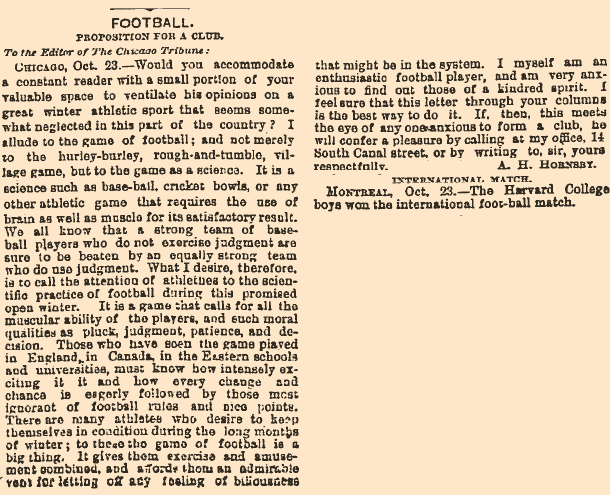
On
a side note, the mention of the "Harvard College boys" in the text above refers to the
now-legendary game that Harvard played against an all-star team in
Canada, which was another critical game in the development of the rules
of American football.
Hornsby got his wish: readers must have responded, because in a matter
of days he had formed the Chicago Football Club and was preparing for
what would be the very first organized game of football in Chicago
history. That game was supposed to be against the Chicago Barge
Club, but the local boating and social club could not muster enough
players. So, instead of a full game, the two clubs held a scrimmage in
November 1875 According to the Tribune, the scrimmage was a "rather
mixed-up affair," since both clubs were still somewhat unfamiliar with
the (still evolving) rules. The two clubs swapped a few players and
staged several football plays.
The Chicago Football Club, again taking its cue from the Eastern
colleges, scheduled a Thanksgiving Day football game and made its
second attempt at a game, again ending in a simple scrimmage.
Their third scrimmage was held on Christmas Day, but was not
played against an outside team-- the Club simply played an extended
intrasquad practice. For the first full game with an outside
team, and
its first game of 1876, the CFC chose to play Northwestern on the
Washington's Birthday holiday.
To prep for the game, the CFC informed NU of the new rules of football,
and NU chose 20 students for its first organized football team.
The student group was led by a team president, Frank F. Casseday.
Casseday, a junior studying Latin and the sciences, came from Evanston
and played on the school's baseball team.
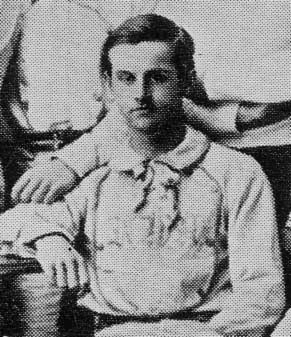 Casseday, posing during the 1875-76 school year
Casseday, posing during the 1875-76 school year
with the "NWU" baseball team [NU Photo]
Among the other members of the original Northwestern football team:
senior Walter Lee Brown, who studied chemistry at NU; and Edward
Kinman, a classics sophomore from Jacksonville, IL, who played
alongside Casseday on the baseball team.4
The Tribune ran the following article leading up to the game5:
The
article is particularly notable because it lists, for the first time
anywhere, the earliest football players representing the city of
Chicago.
And so football came to Northwestern on Tuesday, February 22,
1876. NU hosted the game in Evanston. The game was a relatively
big event, and reporters from several Chicago papers as well as NU's
student paper were on hand to cover the game. The Tribune's
account of the game, a three-goal to nothing loss for Northwestern, was
as follows:
"Yesterday
the Chicago Football Club visited Evanston to play a game against
the Northwestern University students. The game was something new
to
the University men, and no preparation had been made for the visitors
in
the way of laying out the playing field. Added to this, the
ground
was frozen so hard that neither goal-posts or line-stakes could be set
up.
It was finally agreed to let the University play twenty men against the
Chicago
team of fifteen, and get along the best way possible under the
circumstances.
"At 3:15 the game was called,
the Chicago Captain kicking off. The
college men were evidently at sea in regard to the game, for they let
Hornsby
follow the ball up, and his next kick took it across the line, enabling
him
to get a touchdown. The try at goal was successful-first to the
Chicago.
Time, 1 minute 30 seconds. The second goal was a longer tussle,
but
finally Curtis got the ball, and after a good run touched it
down.
Hornsby again scored a goal from the place kick. By this time the
home
players were picking up some of the points of the game, and their
greater
number made it difficult for the Chicago men to get through such a
crowded
field.
"L.H. Sullivan secured another
touchdown, a good long run, but Hornsby failed
to get the ball between the goal-posts. Before another goal was
scored
half time was called and ends changed. After this the original
twenty
players of the University team increased so alarmingly in number that
getting
through with the ball was an impossibility, and loose scrimmages took
place
over the entire field, but mainly in the University half.
"C.J. Williams at last scored a
goal from a free kick opposite goal.
A second time the same player essayed a free kick, but from a more
difficult
position, and he failed, owing to the wind carrying the ball off.
"The
game was prolonged a quarter of an hour over the hour agreed upon, and
when called the score stood 3 goals for Chicago, to nothing for the
University.
The latter, though beaten, have some good material to make a team from
if
they will practice the game under the rules. . . . "6
The Chicago Times7 reported that the NU players were given the choice of goals to defend and chose to kick with the wind.
The school newspaper The Tripod8 later reported that the NU team "intend
to give those representatives of 'Old Rugby' [the Chicago Football Club] a hard
time to beat them in a scrimmage when they come here again."
It is unlikely that the CFC and NU met for a rematch. The
CFC continued to play during 1876, but nothing is recorded of them
afterward. Another Chicago Football Club appeared in the early
1880s, but this was a soccer club that was unrelated to Hornsby's
group. As for Northwestern, the players did not face another team
from outside the university that year. In 1878 they made several
attempts to play an intercollegiate game, but did not do so. NU
did play a couple of games against high schools in 1879 and 1880, all
unofficial. Finally, in 1882 the school played its first
intercollegiate game against Lake Forest, and this is where the
official history of the team begins.
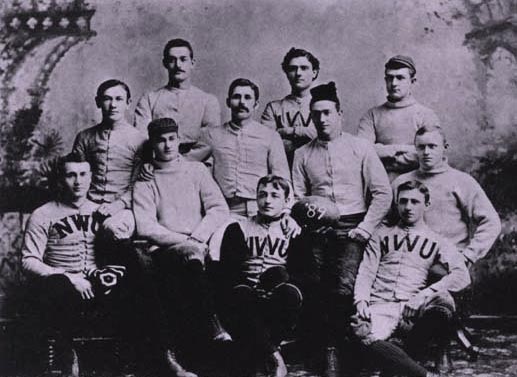 NU
football team, 1889, the earliest known image of the team. Photo
from NU
Archives.
NU
football team, 1889, the earliest known image of the team. Photo
from NU
Archives.
By the early 1900s, when the school began to keep historical records of
the team, the 1876 game had already slipped from memory. Walter
Paulson does mention the game in his book, The
Tale of the Wildcats.
Paulson, NU's sports publicity director, wrote the book in conjunction
with
the school's centennial celebration in 1951. In that book,
Paulison
writes:
"The first evidence of any football activity at
Northwestern appeared in
an article in The Tripod of
Feb. 24, 1876, which said: 'The trial game of
football on Tuesday last enthused the boys so much that they formed a
Football
Association and intend to give the representatives of "Old Rugby" a hard time in a scrimmage
when
they come here again.' Just who the representatives of 'Old
Rugby'
were is not known. . . ."9
While
Paulson found and noted the Tripod account, he was clearly unaware
of the
Chicago Times or Tribune accounts of the game, which told exactly who
played for the Chicago Football Club and showed decisively that the
game was an organized event
with a Northwestern team selected to represent the university against a
functioning football club.
The account in Paulson's book is also given on the NU
Archive's football
history webpage. Again, looking only at the Tripod article, it is not clear if 'Old Rugby' was an
organized
team, nor if the game played at NU was truly "football" at all. However, given the other sources, it is clear that NU did, indeed, play a verifiable
American football game,
against a team from Chicago in February 1876.
That the
opponent
was not another college should not matter: NU officially records its
games
with other amateur teams during the 1880s and '90s 10.
Now that this game is officially recognized by the University, it pushes back the
official origin
of NU football over six years, three years before Michigan's heralded
debut
on the field, and gives NU the claim as the oldest football team
in
the Midwest.
One source had already considered Northwestern the oldest team in the
midwest. ESPN released its College Football Encyclopedia in
2005. ESPN recognized the 1876 game with the Chicago Football
Club, and it lists (on page 1138) Northwestern as the sixth college
(among FBS or FCS schools) to take up football. Only Princeton,
Rutgers, Columbia, Yale, and Harvard have older histories.
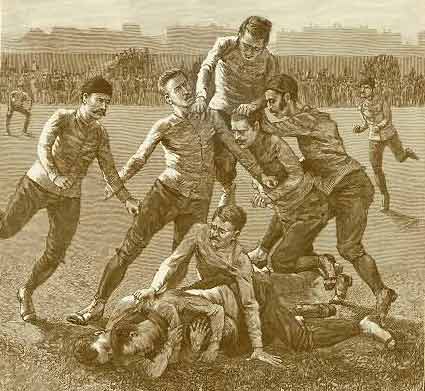 Drawing of how football was played around the time of
the Northwestern-
Drawing of how football was played around the time of
the Northwestern-
Chicago Football Club game in 1876.
1. Note that this does not refer to the current Haas Park in Logan Square, but to a much older Haas Park.
2. Weyand, Saga of American Football, 1955.
3. Text image taken from the October 24, 1875 Chicago Tribune.
4. Student information from Northwestern University Catalog, 1876-1877 school year.
5. Text image taken from the February 20, 1876 Chicago Tribune.
6. Chicago Tribune, February 23, 1876.
7. Chicago Times, February 23, 1876.
8. Northwestern Tripod, February 24, 1876.
9. Paulison, Tale of the Wildcats, 1951.
10. Cf. NU official records for NU vs. Chicago Wanderers, 1889; NU vs.
Denver Athletic Club, 1893; NU vs. Chicago Athletic Club, 1896 and
1898.


|
|
|

